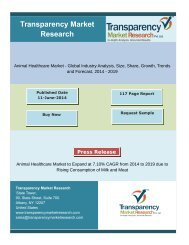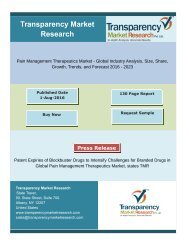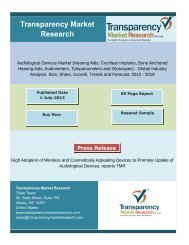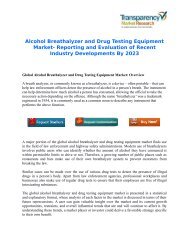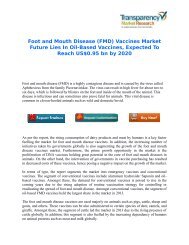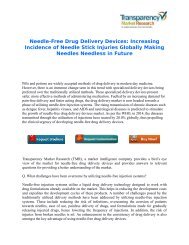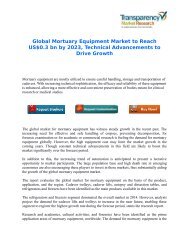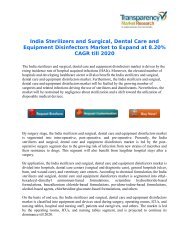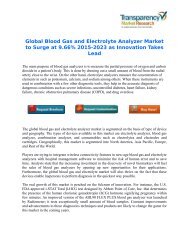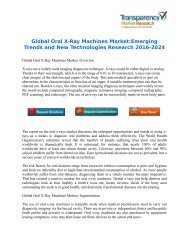Progressive Supranuclear Palsy (PSP) Market - Global Industry Analysis
Palsy is a class of neuro-degenerative disorders affecting many people worldwide. Frequently seen among the geriatric population, palsy is not necessarily endemic to older generation or a specific race, infact they have also been reported in much younger populations, although the reason may be different (trauma/abuse). Progressive supranuclear palsy is a type of palsy, specific to older populations, wherein certain sections of the brain die due to various, yet unknown reasons. The most plausible explanation for PSP found is the variation in the tau protein synthesis that leads to collapse of neurological cells in the brain.
Palsy is a class of neuro-degenerative disorders affecting many people worldwide. Frequently seen among the geriatric population, palsy is not necessarily endemic to older generation or a specific race, infact they have also been reported in much younger populations, although the reason may be different (trauma/abuse). Progressive supranuclear palsy is a type of palsy, specific to older populations, wherein certain sections of the brain die due to various, yet unknown reasons. The most plausible explanation for PSP found is the variation in the tau protein synthesis that leads to collapse of neurological cells in the brain.
You also want an ePaper? Increase the reach of your titles
YUMPU automatically turns print PDFs into web optimized ePapers that Google loves.
<strong>Progressive</strong> <strong>Supranuclear</strong> <strong>Palsy</strong> (<strong>PSP</strong>) <strong>Market</strong> -<br />
<strong>Global</strong> <strong>Industry</strong> <strong>Analysis</strong>, Size, Share, Growth,<br />
Trends and Forecast, 2014 - 2020<br />
Single User License:<br />
USD 4315.5<br />
<br />
<br />
<br />
<br />
Flat 10% Discount!!<br />
Free Customization as per your requirement<br />
You will get Custom Report at Syndicated Report<br />
price<br />
Report will be delivered with in 15-20 working days<br />
Transparency <strong>Market</strong> Research<br />
State Tower,<br />
90, State Street, Suite 700.<br />
Albany, NY 12207<br />
United States<br />
www.transparencymarketresearch.com<br />
sales@transparencymarketresearch.com<br />
Request Sample<br />
Buy Now
REPORT DESCRIPTION<br />
<strong>Palsy</strong> is a class of neuro-degenerative disorders affecting many people worldwide. Frequently seen among the geriatric population, palsy is not<br />
necessarily endemic to older generation or a specific race, infact they have also been reported in much younger populations, although the reason<br />
may be different (trauma/abuse). <strong>Progressive</strong> supranuclear palsy is a type of palsy, specific to older populations, wherein certain sections of the<br />
brain die due to various, yet unknown reasons. The most plausible explanation for <strong>PSP</strong> found is the variation in the tau protein synthesis that leads<br />
to collapse of neurological cells in the brain.<br />
The prominence of this factor has been studied in many patients, however it hasn’t been accepted as the primary cause for <strong>PSP</strong>, instead scientists<br />
believe tau protein variation may play an assisting role in <strong>PSP</strong>. The initial symptoms of <strong>PSP</strong> are similar to Parkinson’s disease, which involves<br />
frequent loss of balance, forward stoop, frequent collisions while walking, etc. Visual symptoms, i.e. nystagmus, inability to frequently close<br />
eyelids, difficult in focusing near objects, double vision and difficulty in moving eye in a vertical axis, are some of the primary symptoms that<br />
differentiate palsy from Parkinson’s disease. In the later stages a patient may exhibit behavioral changes, dementia, swallowing difficulties and<br />
speech slurring, to name a few.<br />
Browse Full Report With TOC:- http://www.transparencymarketresearch.com/progressive-supranuclear-palsy.html<br />
In extreme cases, paralysis and inability to move the neck is also reportedly seen. <strong>PSP</strong> is confirmed with an MRI of the brain, where brain clots or<br />
decay show affirmative signs. <strong>PSP</strong> diagnosed patients often have a window of 4-10 years, on an average 7 years until their death. The disorder<br />
has the prefix “<strong>Progressive</strong>” for the very same reason that <strong>PSP</strong> once diagnosed, is sure to result in total brain death for the patient in the near<br />
future.<br />
Treatments or cure for <strong>PSP</strong> do not exist as of date, symptomatic relief can however be provided to patients to ease their discomfort and pain.<br />
Treatment wise patients are segregated into levodopa responsive (in case Parkinsonism is accompanied with <strong>PSP</strong>) and levodopa unresponsive.<br />
Sometimes levodopa unresponsiveness is also used as a differentiating test for <strong>PSP</strong> from Parkinson’s, however a majority of medical practitioners<br />
believe both conditions can coexist in individuals. Migraine medications are given to ease headaches, which are frequent and cause much<br />
discomfort later on. OnabotulinumtoxinA is also administered as injections to ease dystonia and muscle rigidity. Methylcellulose eye drops are<br />
administered to patients with conjunctivitis, this is because <strong>PSP</strong> patients’ exhibit lower eyelid blink rate, thereby increasing their susceptibility to<br />
eye infection.
The prevalence of <strong>PSP</strong> is moderately high, with various statistics showing occurrence among one in 16,000 to one in 100,000. Many famous<br />
celebrity cases of <strong>PSP</strong> has generated interest in the market worldwide, developed nations are the best in diagnosing patients with <strong>PSP</strong>, whereas in<br />
developing nations patients are usually confused or broadly labeled as regular palsy. The market for <strong>PSP</strong> therefore lies majorly in North Americas<br />
and Europe. Product wise the sales of Parkinson’s disease medicines have seen large sales in the Asia-Pacific region, together with migraine<br />
treatments and eye infections market. Large populations have been observed to be the major cause, as <strong>PSP</strong> and Parkinson’s have no racial or<br />
genotypic specificities. Rehabilitation centers and nursing homes for <strong>PSP</strong> patients have seen success in the U.S and Europe along with Canada<br />
and Australia. Such centers are on the rise recently in Asia too.<br />
Some of the major manufacturers of levodopa/carbidopa are: Merck & Co, Aton Pharmaceuticals Inc., Bristol Myers Squibb Co., etc. Migraine<br />
drugs include anti-inflammatory and pain management drugs, some of these manufacturers include: GlaxoSmithKline PLC, Novartis AG, Teva<br />
Pharmaceutical Industries Ltd., etc.<br />
This research report analyzes this market on the basis of its market segments, major geographies, and current market trends. Geographies<br />
analyzed under this research report include<br />
<br />
<br />
<br />
<br />
<br />
North America<br />
Asia Pacific<br />
Europe<br />
Middle East and Africa<br />
Latin America<br />
This report provides comprehensive analysis of<br />
<br />
<br />
<br />
<br />
<br />
<strong>Market</strong> growth drivers<br />
Factors limiting market growth<br />
Current market trends<br />
<strong>Market</strong> structure<br />
<strong>Market</strong> projections for upcoming years
This report is a complete study of current trends in the market, industry growth drivers, and restraints. It provides market projections for the coming<br />
years. It includes analysis of recent developments in technology, Porter’s five force model analysis and detailed profiles of top industry players.<br />
The report also includes a review of micro and macro factors essential for the existing market players and new entrants along with detailed value<br />
chain analysis.<br />
Reasons for Buying this Report<br />
<br />
<br />
<br />
<br />
<br />
<br />
<br />
This report provides pin-point analysis for changing competitive dynamics<br />
It provides a forward looking perspective on different factors driving or restraining market growth<br />
It provides a six-year forecast assessed on the basis of how the market is predicted to grow<br />
It helps in understanding the key product segments and their future<br />
It provides pin point analysis of changing competition dynamics and keeps you ahead of competitors<br />
It helps in making informed business decisions by having complete insights of market and by making in-depth analysis of market segments<br />
It provides distinctive graphics and exemplified SWOT analysis of major market segments<br />
Request Brochure:- www.transparencymarketresearch.com/sample/sample.php?flag=B&rep_id=2715<br />
More Pharmaceutical Reports: http://www.transparencymarketresearch.com/pharmaceutical-market-reports-1.html<br />
About Us<br />
Transparency <strong>Market</strong> Research is a market intelligence company providing global business information reports and services. Our exclusive blend<br />
of quantitative forecasting and trends analysis provides forward-looking insight for thousands of decision makers.<br />
TMR’s experienced team of analysts, researchers, and consultants use proprietary data sources along with various tools and techniques to gather<br />
and analyze information. Our business offerings represent the latest and the most reliable information which is indispensable for businesses to<br />
sustain their competitive edge.
Contact Us:-<br />
Transparency <strong>Market</strong> Research<br />
90 State Street,<br />
Suite 700,<br />
Albany<br />
NY - 12207<br />
United States<br />
Tel: +1-518-618-1030<br />
USA - Canada Toll Free 866-552-3453<br />
Email: sales@transparencymarketresearch.com<br />
Website: http://www.transparencymarketresearch.com/<br />
Browse <strong>Market</strong> Research Blogs:<br />
https://herepharmablog.wordpress.com





